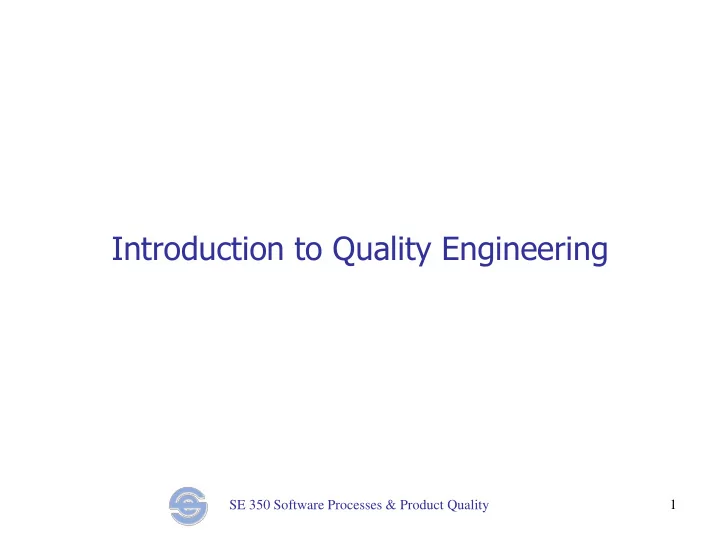

Introduction to Quality Engineering SE 350 Software Processes & Product Quality 1
Quality: Two Views Conformance to requirements (absence of defects). Narrow definition (sometimes referred to as q). Fitness for use (relative to needs). Broader definition (referred to as Q). Relative to actual needs, not just written requirements. Includes other attributes (product quality, project business objectives, organizational objectives). SE 350 Software Processes & Product Quality 2
Quality Engineering “Optimize” quality (not maximize) Preferred tradeoff among multiple objectives For example: Achieve desired quality levels within cost bounds Aim is to design systems and systematic approaches that continually work towards this optimum. SE 350 Software Processes & Product Quality 3
Limitations of Quality Engineering Quality frameworks define what to do and how to do it, and measure the outcomes. They can identify and eliminate problems. But their effectiveness depends on the people who do the activities involved. Frameworks cannot deliver excellence. Only people can deliver excellence. SE 350 Software Processes & Product Quality 4
Processes (Systematic) steps for accomplishing a task “Structured” approach to getting things done. The best process for a task is that which accomplishes the task most effectively, that is, optimizes across task objectives. SE 350 Software Processes & Product Quality 5
More Process vs. Best Process Processes maximize probability of successful task accomplishment, that is, prevent problems. “More process” (more formality and ceremony) improves probability of success, but runs counter to other objectives (such as cost, flexibility). “Best” process optimizes across task objectives, hence more process is not always good. SE 350 Software Processes & Product Quality 6
Process Design Designing good processes requires: Understanding the various task objectives. Understanding the impact of the steps involved (process design decisions) on all the different objectives. Creatively identifying different possible approaches (process designs) and picking the best. A typical engineering design problem! SE 350 Software Processes & Product Quality 7
Limitations of Process Processes are designed to prevent problems (“reduce variance of output”). Process is not free – there is a cost in time and effort, as well as in flexibility. Processes incorporate assumptions about the nature of the task and about the objectives – but every situation is a little different. The more the difference, the less effective the process. Process customization (tailoring) is not free! SE 350 Software Processes & Product Quality 8
Metrics The purpose of metrics is to provide evaluation and feedback Try walking to the door with your eyes closed. They can provide an “objective” view to complement the subjective view of the people doing the job. When skillfully used, metrics can reveal longer-term trends that are harder to spot otherwise Filter out random variation SE 350 Software Processes & Product Quality 9
Metrics Interpretation Metrics tell us something, but to make sure that the numbers don’t mislead us, we need to do a lot of additional work “behind the scenes” Doing this requires: Metrics understanding Domain understanding Familiarity with the specifics of the situation SE 350 Software Processes & Product Quality 10
Metrics Interpretation… Any chart should be accompanied by comments that point out what lies behind the numbers. This is the real value added by the quality engineer! SE 350 Software Processes & Product Quality 11
Famous Lines About Metrics “There are three kinds of lies: lies, damned lies and statistics” “What statistics reveal is interesting, but what they conceal is vital” SE 350 Software Processes & Product Quality 12
Another Famous Line “If you can’t measure it, you can’t control it” (The idea is that measurement helps to close the feedback loop, which is necessary) Flip side: “If you manage purely by the numbers, all you manage is the numbers” (Objectives that are not measured will not be met, and some of them may be the most important ones. And as we have seen, numbers don’t reveal the entire truth) To ponder: Is the goal to “control” the outcomes, or to facilitate achievement of better outcomes? SE 350 Software Processes & Product Quality 13
Conclusion Quality engineering is about effective ways to achieve project objectives. Processes and metrics are enablers to achieve these objectives. Defining good processes and selecting good metrics is a challenging design problem. Metrics interpretation is critical. If not done well, all work collecting data etc. is useless. SE 350 Software Processes & Product Quality 14
Recommend
More recommend